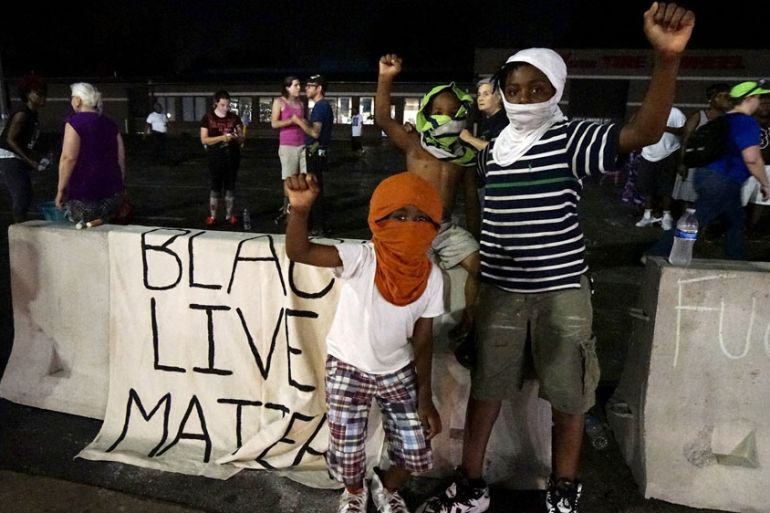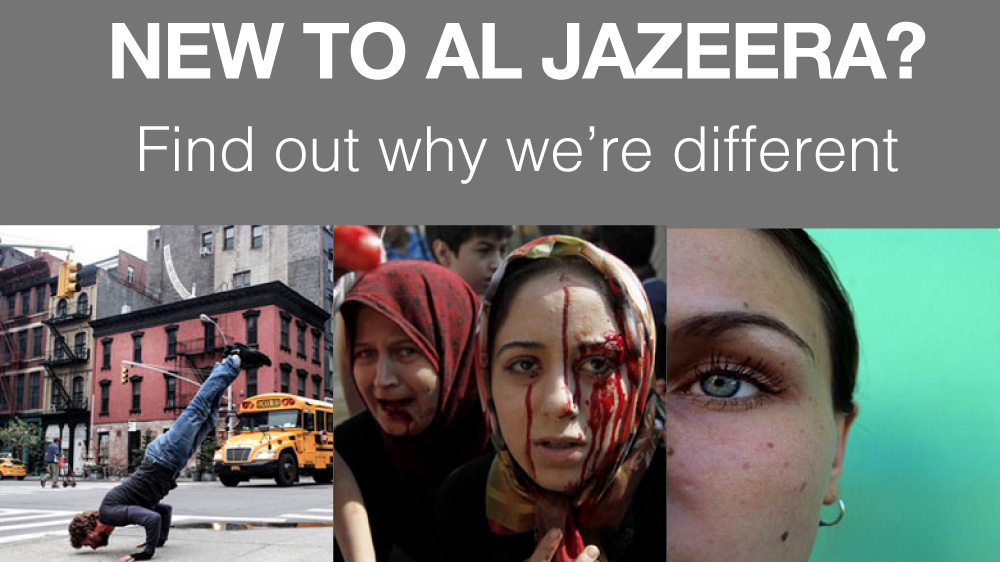Ferguson onward: Two anniversaries
The death of Michael Brown paved the way for the birth of a new civil rights movement.

Face down on the pavement.
A stream of blood trickling away from the 17-year-old’s motionless body.
Keep reading
list of 4 itemsChinese student jailed in US for threatening to ‘cut off hands’ of activist
What happens when activists are branded ‘terrorists’ in the Philippines?
Are settler politics running unchecked in Israel?
Simultaneously staining Canfield Drive and seeding a transformative movement that emerged from that very Ferguson street.
Today marks one year since Darren Wilson shot and killed Michael Brown.
The image of Brown’s motionless body on the pavement – where he was left for four hours for onlookers and loved ones to survey – remains embedded in the minds of millions.
As if a scene from war-torn Syria, Brown’s exposed and uncollected corpse signalled an inhuman indifference to black lives.
|
|
| Fault Lines – Ferguson: Race and justice in the US |
Dead and alive.
Both American tradition and status quo, this indifference fuelled violent policing in largely black communities, pumped the school-to-prison pipeline with horrific vigour; and perhaps most cripplingly, pacified opposition to racialised police brutality for far too long.
However, August 9, 2014, birthed a movement that openly challenged this indifference, and confronted the enforcers of it on Ferguson’s streets.
The St Louis suburb became a meeting point, a rallying cry, and indeed an emblem, for an uncompromising movement that demands far more than merely “justice”, but liberation from structural racism.
From slave code to structural racism
Before the drafting of the constitution, US states enacted slave codes that stripped shackled Africans of their humanity.
Reducing them into chattel, beasts of burden, jointly enabling police and slave masters to brutally enforce the subordination of these bonded black bodies.
The underpinnings of today’s structural racism and the circumstances and institutions that endorse violent policing are firmly rooted in the American slavery and racial dialectic.
RELATED: A year after Michael Brown shooting, Ferguson residents reflect on lessons
The enforcers of the law, in largely black spaces, are overwhelmingly white.
And the enforcement of that law, as evidenced in Ferguson, Baltimore, and other concentrated black spaces, is frequently violent and at times fatal.
The Black Lives Matter movement, and the voices that emerged from it, spoke in these terms: Breaking away from demands for “justice” or “fair prosecutions”, activists called for the dismantling of white supremacy, eroding institutionalised racism, and a halt to community policing programmes that linked blackness to criminality.
|
The post-race American myth was dismissed on Ferguson’s streets.
|
The faces of the new civil rights movement had changed, distancing themselves from Jesse Jackson, Al Sharpton and generational figures that monopolised the platform and spoke over the masses; as did the messaging, strategy, and platforms.
Hours after Brown was killed, Ferguson became the US’ Tahrir Square.
Community members joined with local activists, shortly followed by an endless stream of out-of-state protesters echoing the mantra, “black lives matter”.
The post-race American myth was dismissed on Ferguson’s streets.
The racial tapestry of voices calling for an end to structural racism and militarised policing of poor, black communities defied legions of policemen, stood in front of tanks, and endured endless rounds of tear gas.
Michael Brown’s death birthed more than just a movement: It shifted the epistemology and outlook of an entire generation.
A generation that galvanised across racial, social and geographic lines shouting, tweeting and texting: “Black lives matter”.
“Post-race America” was permanently exposed: It was demystified by the string of black and brown bodies that are disproportionately incarcerated, brutalised and shot down by police; and the swelling masses that spoke on their behalf.
Say their names
While Brown’s death spawned a grassroots revolution, it did not put a moratorium on police targeting of black bodies.
In fact, it seemed as if the spotlight the Brown killing placed on police departments nationally only emboldened racialised violence.
Eric Garner was killed weeks before Michael Brown in New York City, and the video of his brutal public execution emerged in the wake of the Ferguson protests.
Months later, 12-year-old Tamir Rice was shot down in Cleveland, Ohio.
The killing of Aura Rosser, a 40-year-old Ann Arbor, Michigan, woman, preceded Rice’s killing by several weeks.
However, Rosser’s death did not receive the national attention or alarm of her male counterparts.
The failure to centre black women, like Rosser, in the movement, prompted an “intersectional” critique of police brutality, and the distinct vulnerability black women face when confronted with police violence.
|
|
| Fault Lines – Ferguson: City under siege |
The movement evolved with each killing, reaching a major flashpoint with the Baltimore protests after Freddie Gray’s death in April.
Within the past month, the mysterious death of Sandra Bland in Texas and the savage gunning down of Sam Dubose in Ohio illustrate that the movement for black lives has exposed – but not yet eroded – the indifference for black bodies within police departments across the country.
Surely, more thorough investigations have been launched, and policemen prosecuted.
But reforming the institutional culture that endorses the indiscriminate targeting of black bodies in the US streets has yet to even begin.
Fair investigations and individual prosecutions address singular cases, not structural symptoms.
RELATED: Ferguson: ‘They were never here to protect us’
Failing to address the latter only ensures more fallen black bodies and immortalised, hashtagged names.
Of the black men and women slain by police, 45 percent were unarmed.
A riveting statistic, matched by findings by the 2015 Police Violence Report that found that a coloured person was three times more likely to be killed by police than a white person.
Structural racism within police departments – not individual policemen or women – was the real culprit.
Moving forward
The Black Lives Matter movement spawned on Ferguson’s streets penetrated into a diverse set of communities.
Apart from being a national movement, auxiliary campaigns demanding an end to anti-black racism in police departments became rallying cries in non-black communities of colour as well.
In Detroit and New York City, for instance, the Campaign to Take on Hate spearheaded initiatives calling into question anti-black racism within Arab and (non-black) Muslim American communities.
Similar efforts were launched by Hispanic and Latino, Asian, and Native American leaderships, highlighting the evolution and expansion of the movement – and its messaging – into previously uncharted spaces.
More than simply a coalition-building effort, non-black people of colour championed the Black Lives Matters for its own sake.

In response to the grassroots momentum, US President Barack Obama has called for demilitarisation of police departments assigned to largely black communities.
Although his vision cites “police diversity” and “mitigating violence” instead of the more sweeping reform activists have called for, starting August 9, 2014, the influence of the Black Lives Matter within the Oval Office cannot be overlooked.
One year after its birth, the movement born in Ferguson is perpetually expanding.
Forever changing how racism is framed and discussed in the US, and promptly responding to brazen police brutality inflicted on black and brown bodies.
With American racism fluidly mutating and adjusting in line with shifting norms, this past year foreshadows that the Black Lives Matter movement has shaped the agility to expose, confront, and gradually dismantle it.
March onward.
Khaled A Beydoun is an assistant professor of law at the Barry University Dwayne O Andreas School of Law.
The views expressed in this article are the author’s own and do not necessarily reflect Al Jazeera’s editorial policy.
